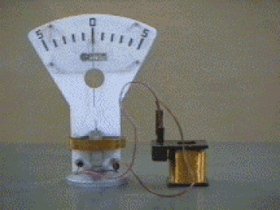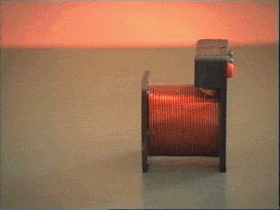

The giant of research in electromagnetism was Davy's pupil, Michael Faraday. In 1831 he discovered the principle of the induction coil and the working basis for electric generators (dynamos) and motors. Faraday also discovered how electrical and chemical forces interact in electrolysis.
Michael Faraday was born in Newington, Surrey - sept. - 22 - 1791. His father was a blacksmith. When he was 13 Michael was apprenticed to a bookbinder. He read all the scientific books in the shop.
Young Faraday attended lectures by Sir Humpry Davy. He made careful notes and sent them to Davy, asking for a job. Impressed by the boy's zeal, the scientist took him into his laboratory as an assistant. Faraday then went on to become one of the greatest experimental scientists of all time.
In 1831 Faraday found that when he moved a magnet trough a coil of wire, a current was produced.
Please see the animation.
Only when he moved the permanent magnet.
Magnetism had been produced from electricity, and Faraday, who all his life long entertained a strong belief in such reciprocal actions, now attempted to effect the evolution of electricity from magnetism. Round a welded iron ring he placed two distinct coils of covered wire, causing the coils to occupy opposite halves of the ring. Connecting the ends of one of the coils with a galvanometer, he found that the moment the ring was magnetised, by sending a current through the other coil, the galvanometer needle whirled round four or five times in succession. The action, as before, was that of a pulse, which vanished immediately. On interrupting the circuit, a whirl of the needle in the opposite direction occurred. It was only during the time of magnetization or demagnetization that these effects were produced. The induced currents declared a change of condition only, and they vanished the moment the act of magnetization or demagnetization was complete.
The effects obtained with the welded ring were also obtained with straight bars of iron. Whether the bars were magnetised by the electric current, or were excited by the contact of permanent steel magnets, induced currents were always generated during the rise, and during the subsidence of the magnetism. The use of iron was then abandoned, and the same effects were obtained by merely thrusting a permanent steel magnet into a coil of wire. A rush of electricity through the coil accompanied the insertion of the magnet; an equal rush in the opposite direction accompanied its withdrawal. The precision with which Faraday describes these results, and the completeness with which he defines the boundaries of his facts, are wonderful.
Faraday and the South Foreland lighthouse
Those notices come from: Faraday as a Discoverer by John Tyndall